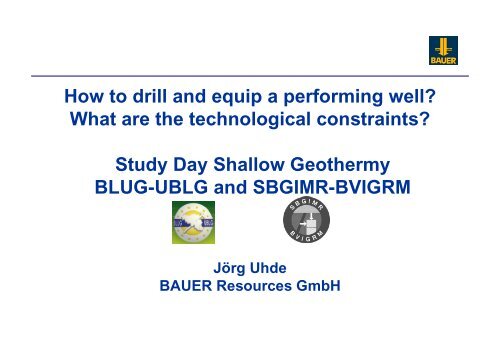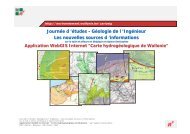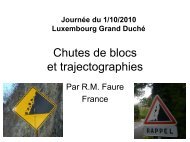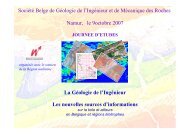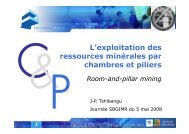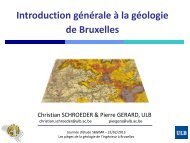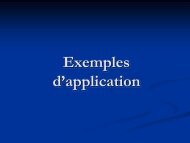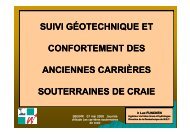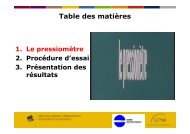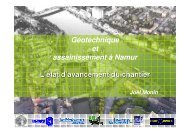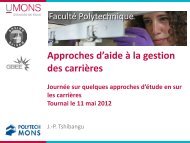GWE ThermoSeal - sbgimr
GWE ThermoSeal - sbgimr
GWE ThermoSeal - sbgimr
Create successful ePaper yourself
Turn your PDF publications into a flip-book with our unique Google optimized e-Paper software.
How to drill and equip a performing well?<br />
What are the technological constraints?<br />
Study Day Shallow Geothermy<br />
BLUG-UBLG and SBGIMR-BVIGRM<br />
Jörg Uhde<br />
BAUER Resources GmbH
� The BAUER Group<br />
� Dimensioning and planning<br />
� Drilling methods<br />
� Installation of borehole heat exchangers<br />
� Grouting<br />
� Connection of borehole heat exchangers<br />
� Results<br />
Contents<br />
2
History<br />
For More Than Two Centuries<br />
After World war II:<br />
beginning of<br />
construction<br />
business<br />
At the end of the 1970ies:<br />
beginning of<br />
Internationalisation<br />
Beginning of 1990ies:<br />
Development of business<br />
area civil<br />
engineering/environmen<br />
tal technology<br />
1790 1950's 1960's 1970's 1980's 1990's 2000+<br />
Company foundation as<br />
blacksmith<br />
Beginning of the<br />
1970ies:<br />
start of<br />
equipment<br />
construction<br />
business<br />
Beginning of the 1980ies:<br />
Selling equipment to<br />
external customers<br />
July 4th 2006:<br />
initial public<br />
offering<br />
Sep. 2006:<br />
initial listing on<br />
SDAX<br />
2006 2007<br />
Business year 2006:<br />
EUR 980 Mio.<br />
result BAUer Group,<br />
5,541 employees<br />
2007<br />
Formation of<br />
BAUER<br />
Resources<br />
GmbH<br />
3
BAUER Group<br />
99 %<br />
BAUER<br />
Spezialtiefbau GmbH<br />
Capital: 37.1m EUR<br />
Free Float<br />
51.84 % 48.16 %<br />
BAUER Aktiengesellschaft<br />
Capital: 73m EUR<br />
Management Board: Prof. Thomas Bauer, Heinz Kaltenecker, Hartmut Beutler, Mark Schenk<br />
99 %<br />
BAUER<br />
Maschinen GmbH<br />
Capital: 26.5m EUR<br />
99 %<br />
BAUER<br />
Resources GmbH<br />
Capital: 10m EUR<br />
Bauer Family<br />
99 %<br />
Schachtbau<br />
Nordhausen GmbH<br />
Capital: 10.2m EUR<br />
99 %<br />
SPESA Spezialbau<br />
und<br />
Sanierung GmbH<br />
Capital: 1.9m EUR<br />
4
BAUER Spezialtiefbau GmbH<br />
Egypt - Alexandria San Stefano Complex<br />
5
BAUER Spezialtiefbau GmbH<br />
Dubai - Burj Dubai<br />
6
BAUER Maschinen GmbH<br />
Péribonka Cutter<br />
7
BAUER Maschinen GmbH<br />
Deep drilling rig TBA 300<br />
8
BAUER Resources GmbH - Materials Division<br />
Products for well drilling<br />
9
BAUER Resources GmbH - Materials Division<br />
<strong>GWE</strong> Flashing material and sealing compound<br />
• Bentonites<br />
• Polymer protecting<br />
colloides<br />
• Loading agent<br />
• Chemicals<br />
• Additive flashing material<br />
• high expension cement<br />
• Seal suspensions<br />
10
BAUER Resources GmbH - Materials Division<br />
Duplex Probe<br />
11
BAUER Resources GmbH - Materials Division<br />
GF-Tec Development and Production of geothermal components<br />
Development, Products & Solutions<br />
New subsidiary<br />
from 1 st Jan 2009<br />
onwards
BAUER Resources GmbH - Exploration & Mining<br />
Foralith AG 700 m well drilling in the East of Switzerland<br />
New subsidiary<br />
13
BAUER Resources GmbH - Exploration & Mining<br />
RC LDD 18" - Kimberlite - RG 40 - Lesotho - South Africa<br />
14
BAUER Resources GmbH - Exploration & Mining<br />
Bulk Sampling - BG 48 South Africa De Beers<br />
15
BAUER Resources GmbH - Exploration & Mining<br />
Geothermal energy - energy pile<br />
16
Dimensioning and planning<br />
Proper design is required in particular<br />
for large installations<br />
Fluid temperature [ºC]<br />
12<br />
10<br />
8<br />
6<br />
4<br />
2<br />
0<br />
-2<br />
-4<br />
-6<br />
JA N FEB MA R APR MA Y JUN JUL AUG SEP OCT NOV DEC<br />
Year 25<br />
Thermal Response Test to determine<br />
ground parameters<br />
Base load<br />
Peak cool load<br />
Peak heat load<br />
Calculation with simple soft-ware<br />
(EED, left) or numerical simulation<br />
(below)<br />
FE-Simulation 5 Jahre, Sondenabstand: 6m<br />
12,8<br />
11,2<br />
9,6<br />
8,0<br />
6,4<br />
4,8<br />
3,2<br />
1,6<br />
0,0<br />
-1,6<br />
-3,3 0 6 12m<br />
12,8<br />
11,3<br />
9,7<br />
8,2<br />
6,7<br />
5,1<br />
3,6<br />
2,1<br />
0,5<br />
-1,0<br />
-2,5<br />
FE-Simulation 5 Jahre, Sondenabstand: 12m<br />
0 6 12m<br />
17
l [W/m K]<br />
6<br />
5<br />
4<br />
3<br />
2<br />
1<br />
0<br />
Dimensioning and planning<br />
Thermal conductivity of selected rocks<br />
Mudstone Limestone Sandstone<br />
Sand<br />
(dry)<br />
Sand<br />
(wet)<br />
Gneiss Granite<br />
average 2,2 2,8 2,3 0,4 2,4 2,9 3,4<br />
min. 1,05 2,46 1,28 0,27 1,73 1,89 2,1<br />
max. 3,02 3,93 5,1 0,75 5,02 3,95 4,07<br />
18<br />
18
Sand / Marl<br />
Marlstone<br />
Granodiorite (max)<br />
Granodiorite<br />
(average)<br />
Granodiorite (min)<br />
Dimensioning and planning<br />
Required meters drilled depending<br />
on thermal conductivity<br />
1901<br />
1983<br />
2584<br />
2666<br />
19<br />
3347<br />
0 1000 2000 3000 4000<br />
19
Drilling methods
Drilling methods
22<br />
Drilling methods<br />
Drilling methods with<br />
circulating mud<br />
– DTH drilling<br />
– Rotarydrilling<br />
– Overburden<br />
drilling
23<br />
Drilling methods<br />
Drilling methods without<br />
circulating mud<br />
– Auger drilling<br />
– Sonic drilling<br />
– High water pressure<br />
drilling (Geojetting)
Drilling methods
Drilling methods<br />
Mobile drilling rig Bauer-Prakla RB 30 GT
Installation of Borehole heat exchangers
Installation of Borehole heat exchangers
Installation of Borehole heat exchangers<br />
Placing the BHE in the borehole, it serves no<br />
purpose to use force above ground to push the Upipes<br />
into the borehole, instead a suitable device<br />
should be used to ensure that any pressure<br />
required is directly applied to the foot of the BHE<br />
and the BHE is therefore drawn into a straight<br />
position.<br />
Generally a water filled BHE must be hold back<br />
initially when placed in the borehole to avoid it<br />
from sliding in too quickly.
Installation of Borehole heat exchangers<br />
At the same time the BHE is placed in the<br />
borehole, the grouting pipe must be fed in.<br />
Dependent on the borehole depth under certain<br />
circumstances several grouting pipes must be<br />
used to ensure continous grouting.<br />
After the BHE has been inserted, but before<br />
grouting of the annular space, a pressure test on<br />
the water-filled BHE is recommended.
Installation of Borehole heat exchangers<br />
Probe installation in wells drilled with mud technology<br />
•Before running-in the probe, the borehole condition has to be checked<br />
with an appropriate survey, like a single shot run<br />
•To reduce lifting forces during installation, the heat pipes should be<br />
filled up with water<br />
•The mud density has to be checked to calculate lifting forces and<br />
required installation weights<br />
•If necessary reduce mud density by adding unweighted polymer fluid<br />
or use a desilter to separate fine solids from the fluid.<br />
•An appropriate method to overcome lifting forces is to use steel<br />
installation pipes which are connected at the probe foot
Installation of Borehole heat exchangers<br />
Preliminary measurements<br />
before installation<br />
• Check the pipes carefully of any damages like rabbles,<br />
grooves etc.<br />
• To avoid the entry of any impurities in the pipe system, seal<br />
the pipes tightly before the are running down in the<br />
borehole<br />
• Always use a reel for the installation work
Installation of Borehole heat exchangers<br />
Stabilize the first probe meters with a steel rod and a tape, to<br />
minimize frictional force during the installation and to avoid<br />
stuck of the probe foot especially when the well shows<br />
different borehole diameters.
Installation of Borehole heat exchangers<br />
At the same time as the BHE is<br />
placed in the borehole, the<br />
grouting pipe / installation pipe<br />
must be fed in.<br />
We recommend a pressure test<br />
with the water filled BHE,<br />
before starting the grouting job<br />
of the annular space.
Installation of Borehole heat exchangers<br />
•Not allowable: Pulling the BHE over the surface ground!
Installation of Borehole heat exchangers<br />
• Probe Centralizer to avoid thermal shorts<br />
between the pipes are recommended or<br />
sometimes mandatory<br />
•Probe Double Centralizer<br />
•Easy click positioning.<br />
•50 mm free space for cementing pipe.<br />
•Installation with 90°/180° offset.<br />
•Probe Centralizer
Installation of Borehole heat exchangers<br />
To make the installation of the borehole heat<br />
exchanger easier, ist is filled with water before<br />
being installed. Even for dry boreholes the BHE<br />
must be filled with water before the borehole is<br />
grouted at the latest, to prevent it from rising up.<br />
It should be checked wether an additional weight<br />
is required at the foot of the BHE.
depth [m]<br />
0<br />
-50<br />
-100<br />
-150<br />
-200<br />
-250<br />
-300<br />
Installation of Borehole heat exchangers<br />
Probe installation in wells drilled with mud technology<br />
•Buoyancy of an unfilled<br />
BHE (PEHD) in water<br />
uplift [kg]<br />
0 200 400 600 800 1000<br />
injectio npipe da 32 simple U-pipe da 32 double U-pipe da 32 double U-pipe da 40<br />
depth [m]<br />
0<br />
-50<br />
-100<br />
-150<br />
-200<br />
-250<br />
-300<br />
•Buoyancy of a water filled BHE<br />
(PEHD) in water<br />
0 5<br />
uplift [kg]<br />
10 15 20 25<br />
injection pipe da 32 simple U-pipe da 32 double-U-pipe da 32 double-U-pipe da 40
depth [m]<br />
0<br />
-50<br />
-100<br />
-150<br />
-200<br />
-250<br />
-300<br />
Installation of Borehole heat exchangers<br />
Probe installation in wells drilled with mud technology<br />
•Buoyancy of a water filled BHE<br />
(PEHD) in drilling mud with a<br />
density of 1,10 kg/dm 3<br />
uplift [kg]<br />
0 50 100 150 200<br />
injection pipe da 32 simple U-pipe da 32 double U-pipe da 32 double U-pipe da 40<br />
depth [m]<br />
0<br />
-50<br />
-100<br />
-150<br />
-200<br />
-250<br />
-300<br />
•Buoyancy of an unfilled BHE<br />
(PEHD) in drilling mud with a<br />
density of 1,20 kg/dm 3<br />
uplift [kg]<br />
0 50 100 150 200 250 300 350<br />
injection pipe da 32 simple U-pipe da 32 double U-pipe da 32 doublel U-pipe da 40
Grouting<br />
Grouting the boreholes is a standard procedure<br />
Grouting of double- or<br />
single-U-pipes after<br />
installing in an open<br />
borehole is a standard<br />
procedure to ensure<br />
• thermal flow between<br />
the bedrock and the Upipes<br />
• protection of the Upipes<br />
• groundwater protection
Grouting<br />
The reasons for grouting are:<br />
• Ensure thermal flow from the bedrock to<br />
the heat carrier fluid during heat<br />
extraction or vice versa for heat injection.<br />
• Sealing the borehole to the surface to<br />
prevent contaminants from entering and<br />
seal aquifers that may have been<br />
penetrated.<br />
• The grouting must guarantee a<br />
watertight and durable, physically and<br />
chemically stable incorporation of the<br />
borehole heat exchanger in the bedrock.
Grouting<br />
• After the borehole heat exchanger has<br />
been put in place and after short<br />
pressure test, the connection of the<br />
BHE to the underground must be<br />
produced by means of a perfect<br />
grouting.<br />
• This means the borehole must be<br />
completely filled up from the footpiece<br />
to the surface without any gaps.
Grouting<br />
The prime concern is prevention of<br />
formation of agglomerates<br />
Fluid - closure<br />
Agglomerates<br />
Defect of quality!
Grouting
Grouting<br />
•Compact injection plant with external hydraulic drive<br />
• Maximum processable solids grains size: 1,0 mm<br />
• Maximum processable slurry density: 1,9 kg/l<br />
• Maximum processable Marsh visc.: 100 s<br />
• Max. pump rate: 2,4 cbm/h<br />
Grouting equipment
Grouting<br />
Grouting materials as ready made “One sack products”<br />
•Thermocem® Mixture of Cement/Clay/Graphite<br />
•Medium density/very high thermal conductivity/freezing stable<br />
•<strong>GWE</strong>- GeoTherm® Mixture of Cement/Clay/Quarzite<br />
•Medium density/high thermal conductivity/freezing stable<br />
•<strong>GWE</strong>- Thermokontakt® Mixture of Cement/Bentonite/Quarzite<br />
•Low density (high yield)/moderate thermal conductivity/low water permeability<br />
•One sack products shows advantages compared to mixtures prepared from<br />
different components at the drill site. Dosages and grout slurry values are<br />
defined in the data sheets of the suppliers. Product quality is controlled by<br />
certified producers.
Grouting<br />
Different types of Aquifers<br />
Lösungskanäle<br />
• Fissure<br />
•rock aquifer<br />
• Carbonate<br />
•rock aquifer<br />
• porous<br />
aquifer<br />
Different standards for grouting materials
Grouting<br />
Porous rock formations<br />
The grouting of the annular space must guarantee a watertight and<br />
durable, physically and chemically stable incorporation of the<br />
borehole heat exchanger in the surrounding rock.
Grouting<br />
Problem !<br />
In cavernous rocks and unconsolidated sediments like coarse<br />
gravel, common grout slurries shows the tendency to run away.<br />
The borehole can not be filled up to top!
Grouting<br />
Solution: <strong>GWE</strong> <strong>ThermoSeal</strong><br />
Parameter <strong>GWE</strong> <strong>ThermoSeal</strong><br />
Pellet dimension ∅8mm; 2-12 mm<br />
Settling velocity 21 m/min<br />
Bulk density 1,1 t/m3 Swelling capacity 40,60 %<br />
Start swelling 15 min<br />
Swelling pressure 9 kN/m2 Permeability 10-11 m/s<br />
New grouting material with enhanced thermal conductivity
Grouting<br />
New Injection pump for the<br />
installation of clay pellets<br />
Technical Specifications:<br />
Max. Pressure Hose Pump: 8,0 bar<br />
Clay Pellets: Ø 8 mm, L = 5-12 mm<br />
Capacity: about 5,5 cbm<br />
Supply line: PEHD pipe 32x2,9 mm
Grouting
Connection of BHE
Connection of BHE<br />
•http://www.gwe-gruppe.de/en/index.html<br />
•http://www.gf-tec.com/
Connection of BHE
Connection of BHE<br />
Horizontal connection is defined<br />
as the junction of single BHE to<br />
common collector-distributor<br />
units. The pipes shall be<br />
connected with parallel circuits<br />
to the distributor. The probe<br />
shall be equipped with valves<br />
for deaeration an regulation.
Respect the minimum<br />
bend radius<br />
Connection of BHE<br />
SDR Dimension Temperature minium bend radius<br />
11 DA 25 20° 25 x DA 25 = 625 mm<br />
11 DA 25 0° 25 x DA 25 x 2,5 = 1562,5 mm<br />
11 DA 32 20° 25 x DA 32 = 800 mm<br />
11 DA 32 0° 25 x DA 32 x 2,5 = 2000 mm<br />
11 DA 40 20° 25 x DA 40 = 1000 mm<br />
11 DA 40 0° 25 x DA 40 x 2,5 = 2500 mm
Filling and de-aeration<br />
The filling of the heat exchanger system should be carried<br />
out by using the ready-mixed heat carrier fluid.<br />
Common antifreeze agents for heat transfer media:
•http://www.zuwa.de/pumps/flushpro.html<br />
Filling and de-aeration
Filling and de-aeration<br />
• Calculation of the needed quantity of heat carrier fluid:<br />
Example tabulation<br />
Pipe diameter [mm] Volume [l/m]<br />
DA 25 (DI 20,4) 0,327<br />
DA 32 (DI 26,2) 0,541<br />
DA 40 (DI 32,6) 0,836<br />
DA 90 (DI 79,2) 4,932<br />
• The filling up procedure is finished after the water in the BHE is<br />
completely displaced by heat carrier fluid<br />
• The concentration of the moving in and leaving out fluid should<br />
be alike.
Filling and de-aeration<br />
Before commissioning, the whole system must be<br />
subjected to a pressure test
Quality management<br />
Also for drilling and installation good quality<br />
work is crucial<br />
61
Quality management<br />
Comprehensive quality<br />
• Quality management<br />
• first class and modern machines<br />
• qualified employees<br />
• permanent further training<br />
• use of high quality materials<br />
• Guaranty of service and price<br />
62
Documentation of<br />
procedure<br />
Pressure test log<br />
Quelle: Dr. Simone Walker-Hertkom<br />
Quality management<br />
Strata print out<br />
Injection log<br />
Graph of lining<br />
63
Quality management<br />
Documentation of procedure<br />
64
Quality miss - management<br />
Staufen, Soutern Germany<br />
65
Quality miss - management<br />
Staufen, Soutern Germany<br />
66
Quality miss - management<br />
Wiesbaden, Germany<br />
67
Quality miss - management<br />
Wiesbaden, Germany<br />
68
Quality miss - management<br />
Kamen, Germany<br />
69
Thank you for your attention !<br />
•Jörg Uhde<br />
•Manager Drilling Services<br />
•Tel.: +49 8252 97-2064<br />
•Fax: +49 8252 97-1845<br />
•Mobil: +49 151 17110464<br />
•Email: joerg.uhde@bauer.de<br />
•Skype: buu,uhde,joerg<br />
•<br />
•BAUER Resources GmbH<br />
•BAUER-Straße 1<br />
•86529 Schrobenhausen, Germany<br />
•www.bauer.de
Shallow geothermal energy systems
Thank you for your attention !<br />
Construction<br />
Passionate<br />
about progress<br />
Machinery Resources<br />
BAUER Drilling Services<br />
72


